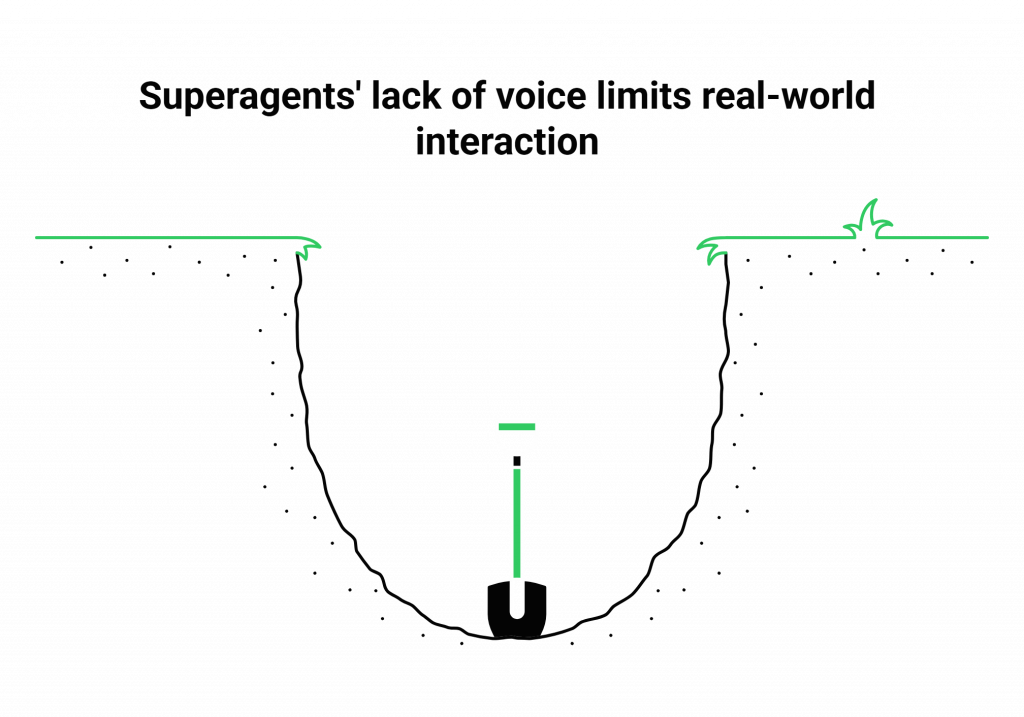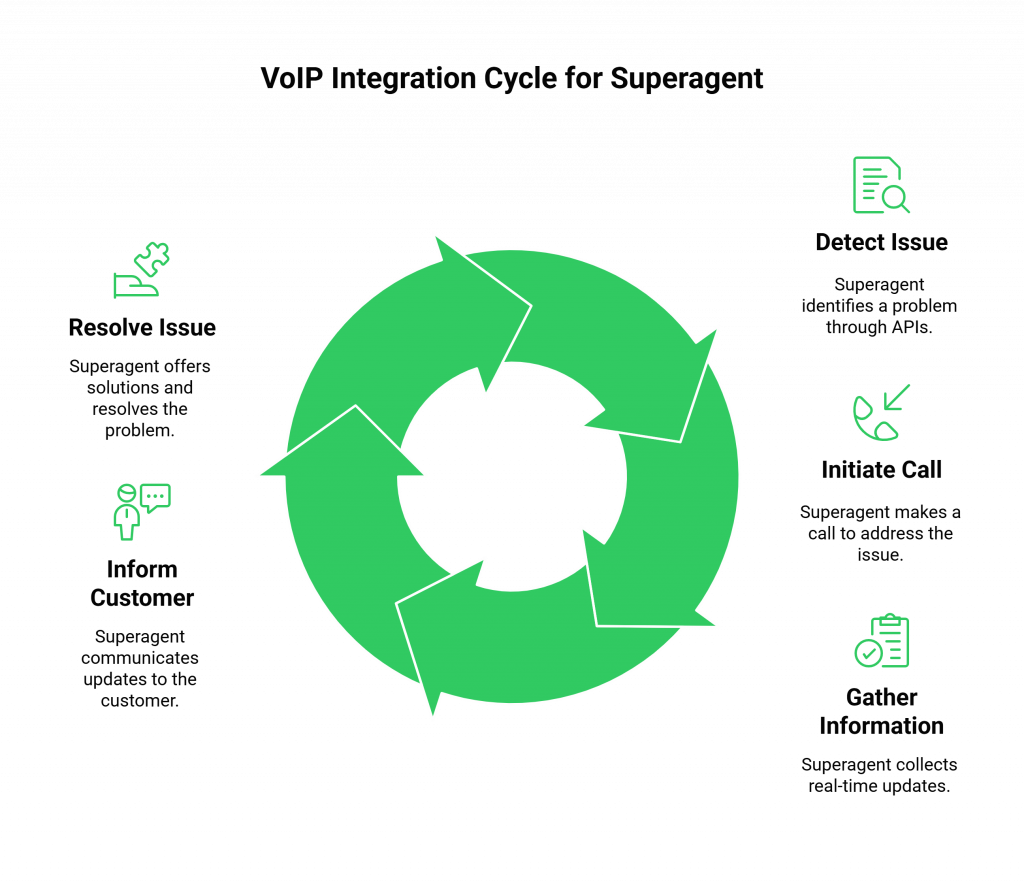For developers building with Superagent, the experience is empowering. You have an open-source framework that lets you construct powerful, data-aware AI agents that can use tools, manage memory, and execute complex tasks. You can build an agent that can reason through a problem and interact with any API on the web.
But what about the most fundamental human API of all: the telephone? This is where a critical technology comes into play, transforming your agent from a digital assistant into a real-world actor: VoIP Calling API Integration for Superagent.
Imagine an agent you built that can do more than just process data. Imagine it can pick up the phone to proactively solve a customer’s problem, call a vendor to negotiate pricing, or conduct a real-time, spoken survey. By giving your intelligent agent a voice, you are not just adding a feature; you are fundamentally expanding its capabilities and the scope of problems it can solve.
This guide will explain exactly how a VoIP Calling API Integration for Superagent elevates your AI agents from powerful tools to truly autonomous assistants.
Table of contents
What is Superagent?
To understand the improvement, we first need to appreciate what Superagent is. Superagent is an open-source framework for building, managing, and deploying AI agents. It is designed for developers who want to create more than just a simple chatbot.

Features of Superagent
- Agent-Centric Design: It is built around the concept of an “agent” that has a specific purpose, access to tools, and memory.
- Powerful Tool Integration: You can easily connect your agent to any API, database, or function. This allows your agent to perform actions, not just generate text.
- Stateful Memory: Agents in Superagent have long-term and short-term memory, allowing them to maintain context across multiple interactions, which is crucial for complex tasks.
- Open-Source and Extensible: As an open-source project, it gives you the freedom to customize and extend the framework to meet your specific needs.
In essence, Superagent provides the “brain” and the “nervous system” for your AI, allowing it to think, remember, and connect to digital tools. But this brilliant brain is often trapped in silence.
The Problem: The “Silent Agent” Limitation

No matter how powerful your Superagent’s logic is, interacting only via text or API calls cuts it off from a huge portion of the real world. Many of the most valuable and time-sensitive business operations happen over the phone. Without a voice, your agent cannot:
- Provide immediate, proactive customer support.
- Schedule an appointment with a business that only takes phone bookings.
- Automate outbound sales or lead qualification calls.
- Handle tasks that require a natural, spoken conversation to resolve.
This is the barrier that a VoIP Calling API Integration for Superagent is designed to shatter.
Also Read: How VoIP Calling API Integration for ElevenLabs.io Improves AI Voice Apps?
How Does VoIP Integration Improve Superagent Agents?
A Voice over Internet Protocol (VoIP) API is the essential bridge that connects your software to the global telephone network. When you integrate one with Superagent, you give your agent the physical ability to speak and listen. Here is how that fundamentally improves your agent’s capabilities.

It Unlocks True, Real-World Automation
Superagent is brilliant at automating digital workflows by calling APIs. A voice integration extends this automation capability into the physical world. Your agent is no longer just a digital task-runner; it becomes a real-world problem-solver.
- Example: Imagine an e-commerce agent built with Superagent that detects a shipping delay from a supplier’s API. Instead of just sending an email, the voice-enabled agent can now automatically call the supplier to get a real-time update, then call the customer to inform them of the delay and offer a solution. This is a level of proactive automation that a silent agent could never achieve.
It Enables Proactive, Stateful Conversations
Superagent’s strength is its memory. A VoIP integration lets this memory power the most stateful form of communication: a live conversation. Your agent can have a dynamic, multi-turn dialogue, using its memory and tools to respond intelligently.
- Example: A customer calls a support line powered by a Superagent agent. The customer says, “My internet is down.” The agent can use its tools to check the network status. If it finds an outage, it can respond, “Yes, I see there’s an outage in your area. The estimated resolution time is 3 PM.” This ability to access tools and maintain context during a live call is a massive improvement.
It Makes Your Powerful Agent Accessible to Everyone
The telephone is the most universal and accessible communication device on the planet. By adding voice, you make your sophisticated Superagent accessible to anyone who can make a phone call, regardless of their technical skill or internet access. A VoIP Calling API Integration for Superagent democratizes access to your AI.
Also Read: Best Practices for VoIP Calling API Integration with Vapi AI
How Does the Integration of Superagent Work?
For a developer, the flow of data is straightforward. A complete voice-enabled Superagent requires four components working in a high-speed loop:

- Superagent (The Brain): Your agent’s core logic, memory, and tool-using capabilities.
- A Voice Infrastructure Platform (The Voice): The VoIP API provider that manages the phone call and the real-time audio streaming.
- A Speech-to-Text (STT) Service (The Ears): Transcribes the human’s spoken words into text.
- A Text-to-Speech (TTS) Service (The Mouth): Converts your agent’s text response into a natural voice.
The cycle of a conversation looks like this
- The VoIP platform receives or initiates a call, opening an audio stream.
- The human speaks. The audio is streamed to the STT service.
- The STT service returns text, which is sent to your Superagent.
- Your Superagent processes the text, uses its memory and tools to decide on the next action, and generates a text response.
- This response is sent to the TTS service, which creates audio.
- The VoIP platform streams this audio back to the human. This loop repeats for every turn of the conversation.
Also Read: Scaling AI Workflows with VoIP Calling API Integration for SynthFlow AI
Why Do You Need FreJun AI?
Superagent provides the brain. STT and TTS provide the senses. But you still need the foundational “nervous system” to connect it all over a phone line with near-zero delay. This is the specific problem FreJun AI solves. We provide the specialized voice infrastructure for your AI.
Our philosophy, “We handle the complex voice infrastructure so you can focus on building your AI,” means we manage the messy world of telephony and real-time audio streaming.
For a developer using Superagent, FreJun AI is the perfect infrastructure layer to reliably connect your agent’s brilliant mind to a human voice with the ultra-low latency that natural conversations demand.
Conclusion
Superagent gives developers the power to build AI agents that can think, remember, and act. But without a voice, their actions are limited to the digital realm. A VoIP Calling API Integration for Superagent is the key that unlocks their true potential. It elevates them from being smart tools that you interact with to autonomous assistants that can act on your behalf in the real world.
By bridging the gap between your agent’s powerful logic and the universal interface of the telephone, you create a new class of AI that is more automated, more interactive, and more accessible than ever before.
Also Read: SIP Trunk Service: Features Every Business Should Look For
Frequently Asked Questions (FAQs)
Superagent is an open-source framework for developers to build AI agents. It makes it easier to give your agents memory, connect them to tools like APIs, and manage complex, multi-step tasks.
Not at all. Modern voice infrastructure platforms like FreJun AI are designed for developers. They provide simple APIs and SDKs that handle all the complex telephony, allowing you to connect your Superagent to a phone number with just a few lines of code.
A proper voice integration waits for your Superagent to fully execute its logic including any connected tools or APIs before generating the final text response to speak to the user.
Superagent is the “brain” that decides what to say. The VoIP API is the “voice box and ears” that handles the mechanics of the phone call, the speaking, and the listening.
